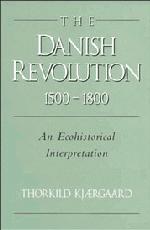Book contents
- Frontmatter
- Contents
- List of Illustrations
- Figure 1 The Danish States: Denmark, Norway, and Schleswig-Holstein in the eighteenth century
- Preface
- Figure 2 Denmark in the eighteenth century
- The Danish Revolution 1500–1800
- Introduction
- Part I Denmark, 1500–1750: A Country in an Ecological Crisis
- Part II The Ecological Revolution
- Part III The New Denmark
- Part IV The Driving Forces behind the Danish Revolution, 1500–1800
- Part V The Inheritance
- Appendix 1 Currency, Weights, and Measures
- Appendix 2 Reigns of Danish Kings and Queens
- Sources and Bibliography
- Index
Introduction
Published online by Cambridge University Press: 03 May 2010
- Frontmatter
- Contents
- List of Illustrations
- Figure 1 The Danish States: Denmark, Norway, and Schleswig-Holstein in the eighteenth century
- Preface
- Figure 2 Denmark in the eighteenth century
- The Danish Revolution 1500–1800
- Introduction
- Part I Denmark, 1500–1750: A Country in an Ecological Crisis
- Part II The Ecological Revolution
- Part III The New Denmark
- Part IV The Driving Forces behind the Danish Revolution, 1500–1800
- Part V The Inheritance
- Appendix 1 Currency, Weights, and Measures
- Appendix 2 Reigns of Danish Kings and Queens
- Sources and Bibliography
- Index
Summary
When the Danish poet Poul Martin M0ller was sailing across the South China Sea on his way to China in 1820, he let his thoughts wander back to his homeland in a poem that he called “The Joys of Denmark”; in his mind's eye he saw cattle standing “in grass up to their knees,” and dreamed of “a clover-field for noonday peace.”
At about the same time, in the vicarage at Købelev on the island of Lolland, Møller's stepbrother, Christian Winther, wrote a poem about the blossoming, sweet-smelling hedges in the Danish countryside. And in the capital, Copenhagen, the grand old poet of the period, Adam Oehlenschlager, praised Denmark as the land of the beech tree:
There is a lovely land
With spreading, shady beeches
Beside the Baltic strand.
Old Denmark will prevail
As long as leafy beech trees
Are mirrored in the waves.
Luminous green beechwoods, sweet-smelling hedges, and fertile fields of clover were felt to sum up the character of the Danish landscape during the nineteenth century, not only for these poets and countless others but also for the Danish people as a whole. In 1936, when Denmark was invited to let herself be represented by her national plants in an international ‘garden of peace’ in La Plata, Argentina, the choice fell on red clover and the beech tree. In the Nature Conservation Act passed the following year, stone fences and hedgerows were mentioned in §1 as being particularly worth preserving.
- Type
- Chapter
- Information
- The Danish Revolution, 1500–1800An Ecohistorical Interpretation, pp. 1 - 6Publisher: Cambridge University PressPrint publication year: 1994

